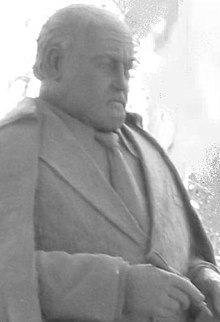Alfonso Reyes (poet)

Alfonso Reyes Ochoa (born May 17, 1889 in Monterrey , † December 27, 1959 in Mexico City ) was a Mexican poet , essayist and diplomat .
Life
Alfonso Reyes came from a wealthy family from Monterrey in the state of Nuevo León , his father General Bernardo Reyes was governor of Nuevo León and minister of defense under Porfirio Díaz . Alfonso Reyes went to school at the Liceo Francés in Mexico City and the Colegio Civil in Monterrey. He then studied law at the Universidad Nacional Autónoma de México in Mexico City and graduated in 1913.
During his studies he began his literary activities. In 1909 he founded the literary circle " Ateneo de la Juventud " ( German cultural community of youth ) together with the young authors Pedro Henríquez Ureña , Antonio Caso and José Vasconcelos . During his studies he also gave lectures on the history of the Spanish language and literature at the national university .
Immediately after graduating in 1913, Reyes was caught up in the turmoil of the Mexican Revolution . During the Decena Trágica in February 1913, the bloodiest fighting of the revolution, his father was shot in front of the National Palace in Mexico City. Alfonso Reyes fled to Paris , where he worked temporarily in the Mexican embassy. When the First World War broke out in 1914, he moved to Spain. After General Álvaro Obregón had gained control of Mexico, he was deputy ambassador to Spain in 1920 and back to France from 1924 . After 1927 he returned to the American continent and was the Mexican ambassador to Argentina and Brazil . During his stay in Buenos Aires he developed a deep, lifelong friendship with Jorge Luis Borges .
After his return to Mexico in 1939, Alfonso Reyes took over the management of the newly founded Casa de España (later renamed El Colegio de México ), a college founded by Spanish civil war refugees and later renamed the Colegio Nacional.
Alfonso Reyes died in Mexico City in 1959 after several heart attacks.
Works
During his student days, Alfonso Reyes began to publish essays on literature and aesthetics as well as his own collections of poetry and stories. The central theme of his work is Mexican identity. The best-known example is his essay “Visión de Anáhuac”, a description of the high valley of Mexico and the fairytale Aztec capital Tenochtitlán , as the Spanish conquerors under Hernán Cortés must have seen. The description “la región mas transparente del aire” for Mexico City goes back to this essay, which became a proverb and, among other things, provided the template for a book by Carlos Fuentes . Reyes' story "La Cena" (German The Last Supper ) from 1917 is considered a forerunner of Surrealism . He also made a name for himself as a translator for authors such as Laurence Sterne , GK Chesterton and Anton Chekhov . Reyes is considered to be the first essayist in Latin America. According to Jorge Luis Borges, Alfonso Reyes is the best prose stylist in the Spanish language.
Essays and prose works
- Cuestiones estéticas (1911)
- Visión de Anáhuac (1915)
- El suicida (1917)
- El cazador (1917)
- La cena (1917)
- Cuestiones gongorinas (1927)
- Discurso por Virgilio (1931)
- Capítulos de literatura española (1939–1945)
- La experiencia literaria (1942)
- El deslinde (1944)
- Trayectoria de Goethe (1954)
Poetry collections
- Cartones de Madrid (1917)
- Break (1926)
- 5 casi sonetos (1931)
- Otra voz (1936)
- Cantata en la tumba de Federico García Lorca (1937)
Lyric theater
- Ifigenia cruel (1924); set to music by Roberto Téllez Oropeza and Leandro Espinosa . Neither of the two operas has been performed in full so far.
Work edition
- Obras completas de Alfonso Reyes . México: Fondo de Cultura Económica. (26 volumes)
See also
- Enrique Díez-Canedo , a friend of Alfonso Reyes
Footnotes
- ↑ Gustavo Sainz (ed.): Human labyrinth. The best Mexican stories . Luchterhand-Literaturverlag, Hamburg and Zurich 1992, ISBN 3-630-86795-2 , pp. 377–378 (author portrait Alfonso Reyes).
Web links
- Literature by and about Alfonso Reyes in the catalog of the German National Library
- Literature by and about Alfonso Reyes (poet) in the catalog of the Ibero-American Institute of Prussian Cultural Heritage, Berlin
- Literature by and about Alfonso Reyes in the catalog of the library of the Instituto Cervantes in Germany
- Website about Alfonso Reyes (Spanish)
- Website dedicated to Alfonso Reyes (Spanish)
- Poem Sol de Monterrey (Spanish)
- Website about the Capilla Alfonsina (Alfonso Reyes house in Mexico City)
| personal data | |
|---|---|
| SURNAME | Reyes, Alfonso |
| ALTERNATIVE NAMES | Reyes Ochoa, Alfonso |
| BRIEF DESCRIPTION | Mexican writer, poet and diplomat |
| DATE OF BIRTH | May 17, 1889 |
| PLACE OF BIRTH | Monterrey , Mexico |
| DATE OF DEATH | December 27, 1959 |
| Place of death | Mexico City , Mexico |